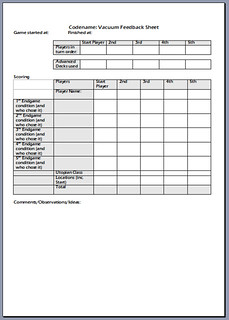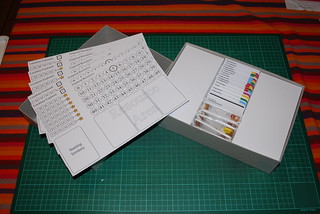Not a huge amount to report this week, I've had my parents up for the week plus I was away for a couple of days on a work trip. As a result I've not made much progress on Codename: Vacuum.
It's not stood still though. I had a playtest game at lunch time one day last week and I've got the first session report from my playtesters in Bedford. As I mentioned last week, they had some issues with the first draft rulebook, but they managed to overcome my inept rulebook writing and played it last week. They've found a bunch more small errors in the cards and rulebook which I'll correct this week. Their game was a long one. There were four players, all new to the game and they were learning it from the (crap) rulebook and it ended up lasting over two and a half hours. It's always the case that a learning game with rules explanation and rule looking up will take longer, but that's still significantly north of what I was hoping for. Having a more structured rulebook that more clearly explains things will help, but the game will need simplifying too. I was hoping for more of a Race for the Galaxy play time than Twilight Imperium. Since Codename: Vacuum doesn't have simultaneous play it'll never be quite as fast as Race, but it can play fairly quickly, and with my experienced players at work we can usually get a game done in under 20 minutes per player. We even got a five player game with one new player done in 1 hour 40 minutes a couple of weeks ago.
Still, the feedback is reminding me that my design ethos definitely is make a complicated game and then simplify it, rather than starting with a simple game and expanding it. Vacuum isn't intended to be a streamlined euro like Sumeria, but there's definitely a lot of scope to simplify things. I'm trying to focus now on re-writing the rules to clarify things, and at the same time, work on those rules that are complicated to write or explain or ones that people often get wrong to try and streamline the game. The simpler it is, the easier it'll be to teach or pick up for the first time. Of course, while doing this, I've got to be careful not to rip out the heart of the game!
In other news, I was contacted a few weeks ago by a previous Reiver Games customer who was interested in playtesting Codename: Vacuum at a convention in Australia. I've been working to get a print-and-play copy ready for him, but in the light of the feedback about the rules quality, I've had to turn him down. I feel bad about letting him down, but I'd rather give him a hand-made copy later (even with the shipping cost to Australia) than provide a poor quality version now.




